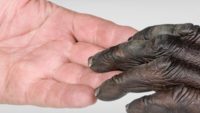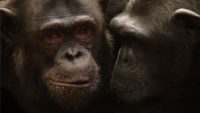Some mammals have an appendix connected to their cecum—the first section of the large intestine—but others don’t. How and when did that once-mysterious organ originate? More… …read more Read more here: icr.org
Paleontologists struggle to definitively answer the conundrum of their origins and the fossil record still says no to evolution. …read more Read more here: creation.com
Did the universe start with the Big Bang? Many Christians believe God used the Big Bang to create all that we see today. But ICR Astrophysicist Dr. Jason Lisle has a different perspective. More… …read more Read more here: icr.org
By Jeffrey P. Tomkins Taken together, genomic data for both the alleged fusion and cryptic centromere sites refute the concept of fusion in a human-chimpanzee common ancestor. …read more Read more here: AIG Daily
Sneak peek of latest Creation magazine. Juvenile cats frozen in time give unique snapshot of the past. …read more Read more here: creation.com
By Dr. Don DeYoung Try standing barefoot on a pile of snow and see how long you last. Ducks do it all the time and aren’t bothered. How is this possible? …read more Read more here: AIG Daily
By Dr. David Menton This amazing organ quietly serves several invaluable roles in our blood system, keeping our bodies healthy. …read more Read more here: AIG Daily
How reliable are the dating methods that say living trees are thousands of years old? …read more Read more here: creation.com
A Chinese famine was so severe that 35 million lives perished between 1958 to 1962 due to the state’s agricultural mistakes. Interestingly, this tragedy highlights an unseen biological relationship between organisms and their environment over multiple generations. More… …read more Read more here: icr.org
Are large craters an indication of the energy forces needed to start and sustain the world’s biggest watery catastrophe? …read more Read more here: creation.com
What “star” did the wise men see? Some say it was a planetary conjunction, and others tell us it was a supernatural manifestation. ICR astrophysicist Dr. Jason Lisle gives his perspective. More… …read more Read more here: icr.org
By Dr. Alan Gillen The emphasis of this article is to explain some of the “very good” design and purpose of Staphylococci and other good, beneficial bacteria of the nose. …read more Read more here: AIG Daily
By invoking a hypothetical to test the hypothetical big bang, two cosmologists develop a model out of nothing. …read more Read more here: creation.com
By Dr. Elizabeth Mitchell Though monkeys can’t imitate human language despite speech-ready vocal tracts because of their brains’ wiring, their versatile alarm calls meet their needs. …read more Read more here: AIG Daily
“This is the last in a series of articles dealing with 15 questions posed to evolutionists. There is a link to the original article below (read it first) as well as the parts 1 and 2 rebuttal articles to all the evolution supporters criticisms of the original article. An excellent and thoughtful read.” Admin Responses to our 15 Questions: part 1 Responses to our 15 Questions: part 2 Here we continue presenting the attempted answers to our 15 Questions for Evolutionists. We’ve compiled many of the answers that we’ve received to date (paraphrased to cover as many [More]
Have evolutionists finally found proof that dinosaurs had feathers? If so, what does it mean? …read more Read more here: creation.com
For creatures to fossilize, special conditions need to exist. …read more Read more here: creation.com
By Dr. Andrew A. Snelling Without accurately known decay half-lives, all radioisotope ages cannot be accurately determined or be considered absolute ages. …read more Read more here: AIG Daily
What was the ‘Z-factor’ that convinced a university geology lecturer of a 6,000-year-old earth? …read more Read more here: creation.com
A tenet of creationist theory maintains that creatures are designed for robust speciation. Although they cannot change into fundamentally different kinds, creatures can rapidly express a wide diversity of traits to fit changing environments. “Fast evolution affects everyone, everywhere” is one headline from the theme of the Royal Society’s life science journal in January, 2017. But its content further bolsters creationist theory. More… …read more Read more here: icr.org
By Dr. Danny R. Faulkner Here I wish to expand upon the phenomenon that caused Rowbotham’s experiment to go awry. Rowbotham was a victim of a superior mirage. …read more Read more here: AIG Daily
By Jennifer Hall Rivera One of the most popular facets of science right now is forensics. But no investigative science is more accurate than an eyewitness account. …read more Read more here: AIG Daily
By Dr. Don DeYoung Your ears are delicate instruments, fine-tuned to hear a wide range of noises. What keeps them from being ripped apart by violent waves of loud vibrations? …read more Read more here: AIG Daily
Exclusive: David Rives notes unexpected finding in Earth’s hardest natural substance Watch: How diamonds disprove evolution
Exclusive: David Rives notes data preclude more than a few thousand years of human existence Watch: Does human population growth reject evolution?
By Dr. Gordon Wilson Eastern box turtles can literally be “frozen alive” and emerge unharmed. …read more Read more here: AIG Daily
Human pregnancies, on average, last 38-40 weeks—approximately nine months. This makes potential genetic change in the human race relatively slow. Not so with Drosophila melanogaster: the fruit fly. If you were to make a short list of creatures that could serve as examples to prove neo-Darwinian evolution to be a legitimate theory, the common fruit fly would probably be on the list.1 Female flies can lay about 500 eggs in their lifetime, and each fly can grow from egg to adult in about a week2—translating to about 50 generations per year. After only a century of testing, scientists have been [More]










































